What is Sex Determination?
- Sex determination refers to the biological process that defines whether an individual organism develops male or female sexual characteristics. This is primarily a genetic process that determines an organism’s sexual phenotype based on the combination of sex chromosomes. In most species, sexual reproduction results in two distinct sexes, male and female. These sexes are often determined by specific chromosome patterns such as XY in humans or ZW in birds.
- In genetic sex determination, the presence of certain chromosomes triggers the expression of key genes. For example, in humans, the Y chromosome contains a gene known as the sex-determining region Y (SRY), which initiates male development. Without this gene, the organism typically develops as female. The genetic mechanism ensures that sex determination is a controlled process governed by the interaction of genes and chromosomes.
- There are other systems of sex determination beyond the common XY system. Some organisms use the ZW system, where females have two different sex chromosomes (ZW) and males have two of the same (ZZ). Additionally, the XO system is observed in certain species where males have only one X chromosome (XO), while females have two (XX).
- In some species, sex determination is influenced by environmental factors rather than purely genetic ones. For instance, in certain reptiles, the temperature during incubation of eggs can dictate whether the offspring will develop as male or female. These environmental systems highlight the diversity of sex determination mechanisms across the animal kingdom.
- Hermaphroditism is another variation seen in some species, where an individual possesses both male and female reproductive organs. Such organisms can potentially reproduce without a partner or change their sexual function depending on environmental conditions.
- While the primary purpose of sex determination is reproductive, modern scientific advancements have explored its role in identifying and potentially addressing genetic or hormonal disorders in developing fetuses. However, the misuse of technologies that determine the sex of fetuses has led to ethical concerns, particularly in practices such as gender-based abortions. Consequently, many governments have restricted the use of these technologies, particularly to prevent the disclosure of fetal sex during prenatal testing.
Definition of Sex Determination
Sex determination is the biological process that establishes whether an individual will develop as male or female, typically governed by genetic, environmental, or a combination of factors. It involves mechanisms that direct the differentiation of gonads and the subsequent development of sexual characteristics.
Methods for Sex Determination
Sex Determination can be done by these methods;
- Chromosomal Sex-Determining Systems
- Genetic Basis of Sex Determination
- Environmental Sex Determination
Chromosomal Sex-Determining Systems
The chromosomal sex-determining systems represent the mechanisms by which an organism’s biological sex is determined through specific chromosomal patterns. There are several variations in these systems, each playing a role in determining whether an individual will develop as male, female, or in some cases, intersex. Below are the primary types of chromosomal sex-determining systems found in nature.
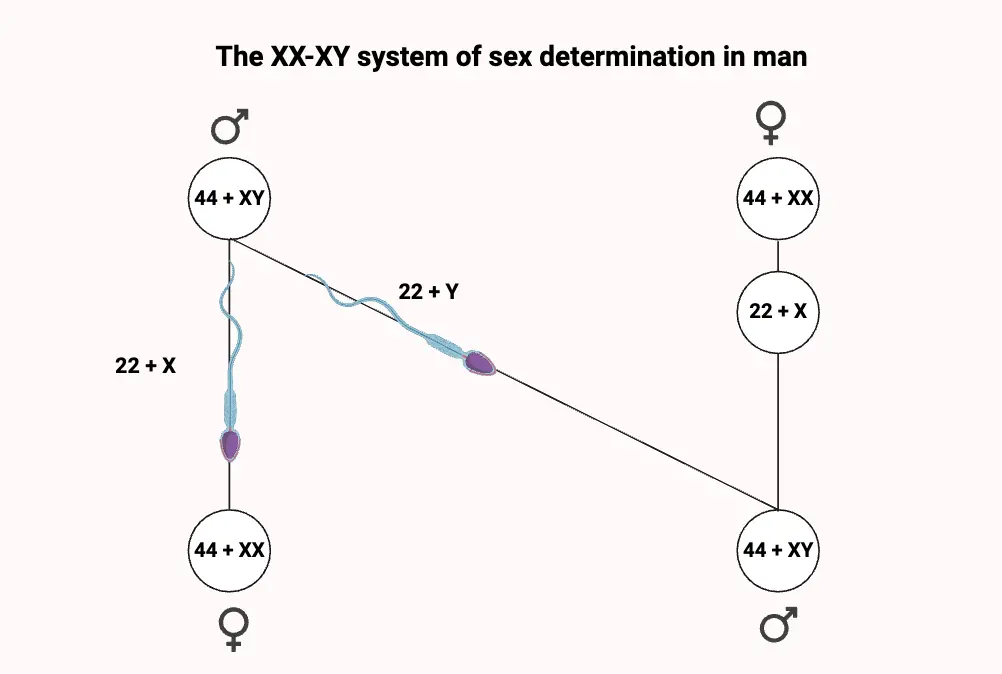
- XX-XY System:
- Overview: This is the most common chromosomal system, found in humans and many animals. In this system, females have two identical X chromosomes (XX), while males have one X and one Y chromosome (XY).
- Mechanism: In females, the X chromosomes pair and function similarly. In males, the presence of the Y chromosome, particularly the SRY gene, directs the development of male characteristics.
- Function: The Y chromosome contains genes that drive male differentiation, including the formation of testes. Without a Y chromosome, the organism develops female characteristics.
- ZZ-ZW System:
- Overview: In this system, the male is homogametic (ZZ) and the female is heterogametic (ZW), reversing the pattern seen in the XX-XY system. It occurs in birds, some fish, and reptiles.
- Mechanism: Here, the female’s ovum determines the sex of the offspring since sperm carry only the Z chromosome.
- Function: Despite the reversal of sex chromosome roles, the ZZ-ZW system functions similarly to the XX-XY system in guiding sexual development.
- XX-XO System:
- Overview: In this system, the female has two X chromosomes (XX), while the male has only one X chromosome (XO), with “O” representing the absence of a second sex chromosome.
- Mechanism: This system results in males having one less chromosome than females, leading to odd chromosome numbers in males and even numbers in females.
- Function: The absence of a second sex chromosome in males leads to differences in reproductive biology, as seen in species like grasshoppers and crickets.
- Ploidy-Level Determination:
- Overview: In some species, sex is determined by the number of chromosome sets (ploidy). Females are diploid, while males are haploid, a system observed in bees, wasps, and some mites.
- Mechanism: Females develop from fertilized diploid eggs, while males arise from unfertilized haploid eggs, producing genetically identical sperm.
- Function: This system increases the genetic relatedness among female offspring, as male gametes are clones of the male parent.
- Compound Chromosome System:
- Overview: In rare cases, sex determination involves multiple chromosomes that group together to behave as a single unit during meiosis. This system is found in species like nematodes and some beetles.
- Mechanism: Several X or Y chromosomes can form compound groups, creating large differences in chromosome numbers between males and females.
- Function: These compound systems add complexity to sex determination, often resulting in variations in sex chromosome configurations across individuals.
- Additional Factors in Sex Determination
- Transfer Gene System: In Drosophila (fruit flies), sex determination involves not only sex chromosomes but also autosomal genes. For instance, the recessive allele tra on an autosome can transform XX females into sterile males when homozygous. This highlights the complexity of sex determination beyond simple chromosomal patterns.
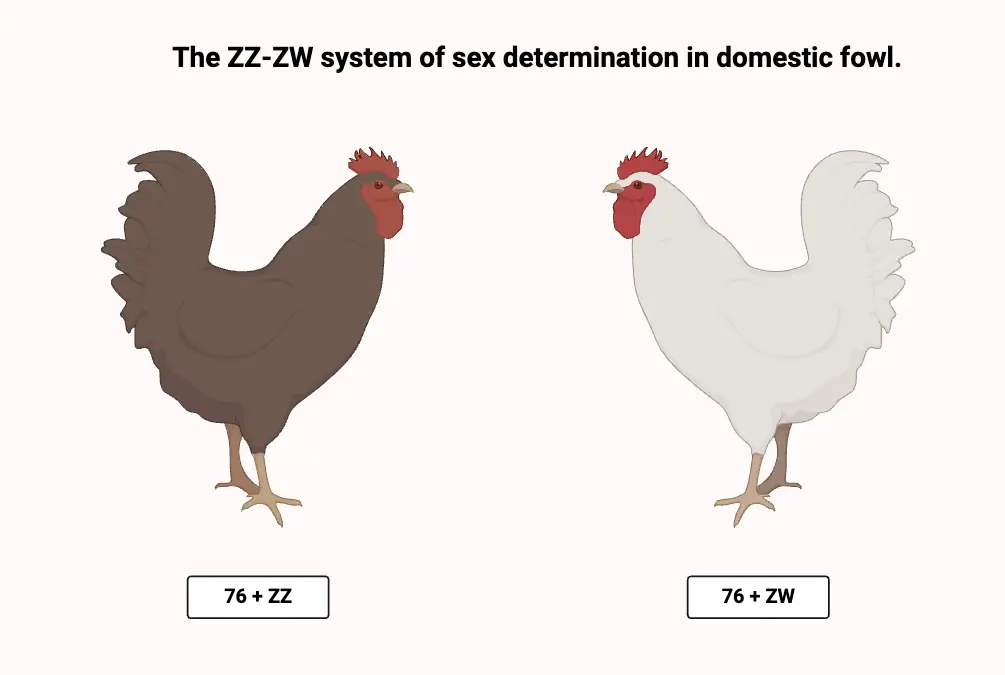
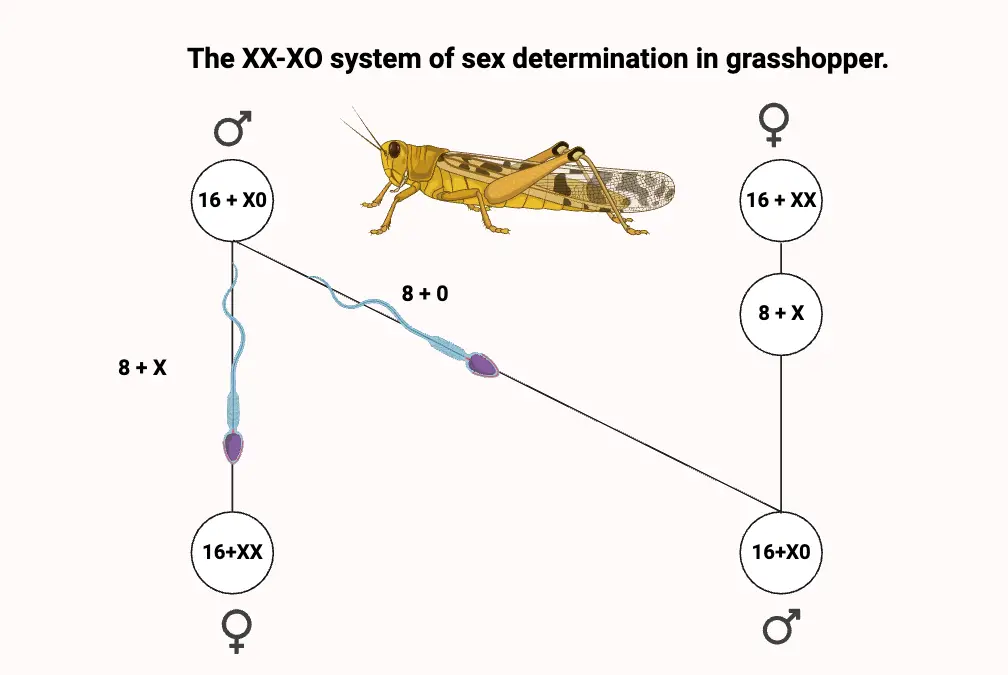
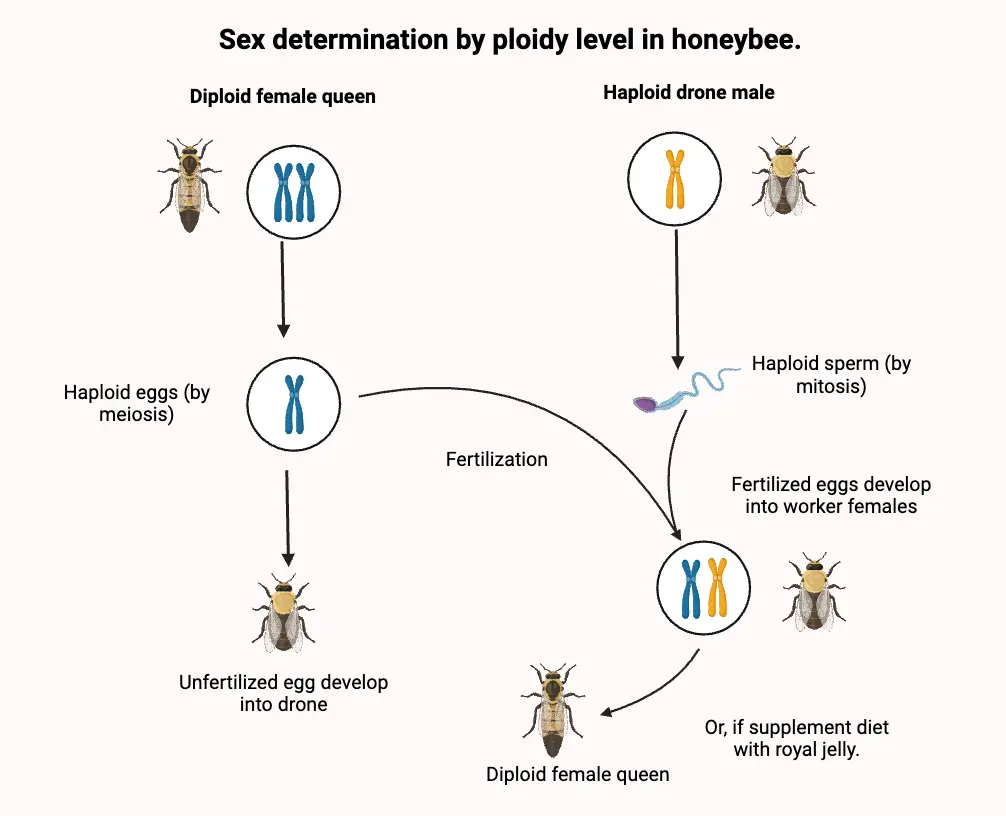
Genetic Basis of Sex Determination
The genetic basis of sex determination is a crucial biological process that governs whether an organism will develop as male or female. In many organisms, sex determination is primarily under genetic control, regulated by specific genes or chromosomes, and is typically established at fertilization. This system ensures that sex is determined independently of environmental factors. The two primary types of genetic sex determination are the genic type and chromosomal type. Below is a detailed and sequential explanation of these mechanisms:
- Genic Type:
- Overview: In the genic type of sex determination, specific genes located on autosomes (non-sex chromosomes) are responsible for determining the sex of an organism. Unlike the chromosomal system, these genes are not confined to specialized sex chromosomes.
- Example: Some fish species exemplify the genic type of sex determination. In these species, the presence of a specific dominant gene, denoted as A₁, determines maleness, while the absence of this gene (represented as AA) leads to femaleness. The genetic configuration (AA₁ for males and AA for females) ensures the sex is established based on the dominance of the A₁ allele.
- Unique Case: In the parasitic wasp Habrobracon, sex is determined through a more complex genetic mechanism. The sex-determining gene has multiple alleles (Xa, Xb, Xc, Xd). If the alleles in a zygote are heterozygous (e.g., XaXb or XaXc), a fertile female develops. Conversely, if the alleles are homozygous (XaXa, XbXb) or hemizygous (Xa or Xb), the zygote develops into a male. This genetic variation allows for different combinations that control the resulting sex of the organism.
- Chromosomal Type:
- Overview: The chromosomal type of sex determination is more common and involves specific sex chromosomes that carry the genes responsible for sexual differentiation. These chromosomes are typically designated as X and Y in mammals or Z and W in other species, such as birds.
- Evolution of Chromosomal Sex Determination: The chromosomal type likely evolved from the genic type, where sex was originally determined by genes on autosomes. Over evolutionary time, these sex-determining genes became localized on specific chromosomes. This specialization led to the development of distinct sex chromosomes, such as X and Y (in the XX-XY system) or Z and W (in the ZZ-ZW system).
- Function of Sex Chromosomes: The Y chromosome (or W in the ZZ-ZW system) plays a crucial role in determining male development. Over time, genes on the Y chromosome accumulated that are essential for male characteristics. These include genes that influence the formation of testes and male reproductive structures. In many species, the Y chromosome has lost much of its genetic material, retaining primarily male-determining genes, while other genes have become inactive or lost.
- Lack of Crossing-Over: In the chromosomal system, crossing-over between the X and Y chromosomes is minimal. This ensures the preservation of gene combinations that favor distinct sexual differences between males and females, leading to the evolution of heteromorphic sex chromosomes. In males, the Y chromosome is typically much smaller and carries fewer genes than the X chromosome.

Environmental Sex Determination
Environmental sex determination (ESD) refers to the process in which an organism’s sex is determined by environmental factors rather than strictly by its genetic makeup. In contrast to genetic sex determination (where sex chromosomes or specific genes dictate whether an organism will develop as male or female), ESD highlights how external conditions, such as temperature or social factors, influence sexual development. Below is an explanation of key examples of environmental sex determination in various species:
- Sequential Hermaphroditism in Slipper Limpets (Crepidula fornicata):
- Overview: In the marine mollusk Crepidula fornicata, also known as the common slipper limpet, sex is determined by its position in a social hierarchy. This type of environmental influence on sex determination is called sequential hermaphroditism, where an organism can switch sexes during its life.
- Process:
- Slipper limpets live in stacks, with each limpet starting its life as a swimming larva.
- The first larva to settle on a solid substrate develops into a female.
- This female then releases chemicals that attract other larvae, which settle on top of the female and develop into males.
- These males function as mates for the female below. After some time, the males on top transform into females and attract more larvae that settle on top of them, repeating the cycle.
- Result: Each stack consists of multiple animals, with the uppermost limpets being male, while the lower limpets, which were previously male, have transitioned into females. This system highlights how social structure and position influence sex determination.
- Temperature-Dependent Sex Determination in Reptiles:
- Overview: In several reptile species, the sex of an individual is determined by the temperature at which eggs are incubated during embryonic development, a process called temperature-dependent sex determination (TSD).
- Examples:
- In many species of turtles, warm incubation temperatures result in more females, whereas cooler temperatures produce more males.
- Conversely, in alligators, cooler temperatures result in females, and warmer temperatures lead to male offspring.
- Function: This mechanism ensures that the sex ratio of a population can be influenced by environmental conditions, which may be beneficial for adapting to changing ecological circumstances.
- Temperature Override of Genetic Determination in Bearded Dragons:
- Overview: In certain species, such as the bearded dragon lizard, environmental factors can override genetic sex determination.
- Genetic vs. Environmental Influence:
- Normally, bearded dragons have genetic sex determination, where males are ZZ and females are ZW.
- However, when eggs are incubated at high temperatures, genetically male (ZZ) individuals can develop as phenotypic females.
- Implication: This phenomenon shows that while chromosomes may initially dictate sex, environmental conditions can play a pivotal role in altering sexual outcomes.
- Summary of Environmental Sex Determination:
- Types of ESD: The diverse mechanisms of environmental sex determination can be classified based on the external factor involved, such as social conditions (as seen in sequential hermaphroditism) or temperature (as seen in reptiles and certain lizards).
- Flexibility: Environmental sex determination allows species to adapt to varying ecological factors, ensuring that population dynamics and reproductive strategies can be adjusted in response to changes in the environment.
Sex Determination in Drosophila melanogaster
Sex determination in Drosophila melanogaster is a unique and well-studied system that deviates from the traditional mechanism observed in many species, where the presence of specific sex chromosomes directly dictates the sex of the organism. In Drosophila, the process is primarily regulated by a balance between the X chromosomes and the autosomes, rather than by the presence of a Y chromosome. Below is a detailed explanation of this mechanism:
- Chromosomal Composition of Drosophila:
- Drosophila melanogaster has a total of eight chromosomes, consisting of three pairs of autosomes and one pair of sex chromosomes.
- Females typically have two X chromosomes (XX), while males possess one X and one Y chromosome (XY). However, the Y chromosome does not determine maleness in the traditional sense, as seen in humans.
- The X: A Ratio Hypothesis:
- In the 1920s, geneticist Calvin Bridges proposed the X: A ratio hypothesis to explain sex determination in Drosophila. According to this theory, the balance between the number of X chromosomes and the number of autosomal sets determines the sex of the fly.
- Formula: X: A ratio = Number of X chromosomes / Number of haploid sets of autosomes.
- A ratio of 1.0 leads to a female phenotype.
- A ratio of 0.5 results in a male phenotype.
- Ratios in between (e.g., 0.67) produce an intersex individual, displaying both male and female characteristics.
- Ratios less than 0.5 or greater than 1.0 lead to abnormal developmental forms known as metamales and metafemales, respectively.
- Key Chromosomal Configurations and Their Sexual Phenotypes:
- XX / AA: X: A ratio of 1.0, resulting in a normal female.
- XY / AA: X: A ratio of 0.5, resulting in a normal male.
- XO / AA: Despite the absence of the Y chromosome, the X: A ratio remains 0.5, leading to a male phenotype.
- XXY / AA: This configuration still yields a ratio of 1.0, resulting in a female phenotype.
- XXX / AA: With an X: A ratio of 1.5, this configuration results in a metafemale, an abnormal developmental form.
- XX / AAA: Here, the X: A ratio is 0.67, leading to an intersex phenotype.
- XO / AAA: With an X: A ratio of 0.33, this results in a metamale, which is also an abnormal developmental form.
- Recent Insights into Sex Determination Mechanisms:
- Although the X: A ratio predicts the sexual phenotype accurately, more recent research has indicated that the original theory by Bridges oversimplified the mechanism.
- It is now understood that genes on the X chromosome play the most crucial role in determining sex. Few autosomal genes directly influence sex determination, as Bridges originally proposed.
- The autosomal sets primarily impact the timing of developmental processes. For example, in XX flies with three autosomal sets (XX / AAA), the presence of additional autosomal material shortens critical developmental stages, preventing sufficient accumulation of female-determining factors on the X chromosomes. This results in an intersex phenotype.
- Therefore, autosomes affect sex indirectly by altering developmental timing rather than through direct genetic influence.
- Summary of the X: A Ratio and Its Implications:
- Primary Determinant: The number of X chromosomes serves as the primary factor in determining the sex of Drosophila.
- Influence of Autosomes: While autosomes do not directly carry sex-determining genes, their influence lies in modifying the duration of developmental events, impacting the expression of sex-determining factors on the X chromosomes.
- Developmental Consequences: Deviations from the standard 1.0 or 0.5 X: A ratio lead to mixed or abnormal sexual phenotypes, highlighting the delicate balance required for normal sexual development in this species.
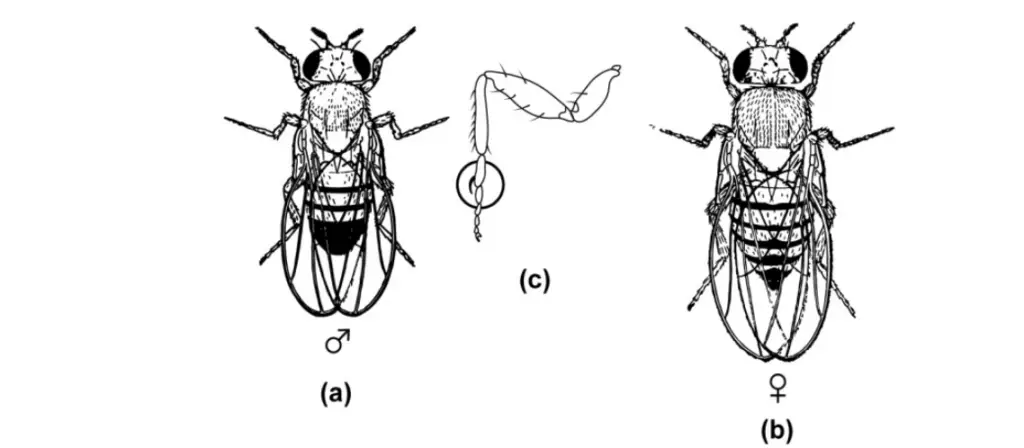
abdomen of the female. (c) shows details of a male leg with sex comb
(arrow).
Sex Determination in Human
Sex determination in humans is a complex and highly regulated process that revolves around the presence or absence of specific sex chromosomes. Unlike in some other organisms, the Y chromosome plays a crucial role in determining maleness. The mechanism of sex determination in humans is rooted in genetic and chromosomal factors, which lead to distinct male and female phenotypes. Below is a structured explanation of the key aspects of sex determination in humans:
1. Chromosomal Basis of Human Sex Determination:
- Humans have a total of 46 chromosomes, including 22 pairs of autosomes and one pair of sex chromosomes (XX in females and XY in males).
- The presence of the Y chromosome is the primary factor that triggers male development, while the absence of a Y chromosome typically leads to female development.
- A critical gene on the Y chromosome, known as SRY (Sex-determining Region Y), is responsible for initiating male differentiation.
2. SRY Gene and Male Development:
- The SRY gene, located on the short arm of the Y chromosome, activates around six weeks after fertilization.
- This gene triggers the development of undifferentiated gonads into testes, which begin to produce two key hormones:
- Testosterone: Promotes the development of male external genitalia and secondary sexual characteristics.
- Müllerian-inhibiting substance: Causes the regression of female reproductive ducts.
- In the absence of the SRY gene, the gonads develop into ovaries, leading to the formation of female reproductive structures.
3. Abnormalities in Sex Chromosome Composition:
Variations in the number of sex chromosomes can result in distinct syndromes, revealing the significance of both the X and Y chromosomes in human sex determination.
- Turner Syndrome (XO):
- Affects approximately 1 in 3,000 female births.
- Individuals have only one X chromosome (XO).
- Common characteristics include short stature, underdeveloped secondary sexual characteristics, and infertility.
- Turner syndrome indicates that at least one X chromosome is required for human development.
- Klinefelter Syndrome (XXY):
- Affects about 1 in 1,000 male births.
- Individuals have an extra X chromosome, resulting in an XXY configuration.
- Symptoms include small testes, reduced facial hair, and infertility. Affected individuals are often taller than average.
- Variants of this condition include XXXY, XXXXY, and XXYY, which tend to exacerbate physical and developmental symptoms.
- Poly-X Females (XXX or more):
- Occurs in about 1 in 1,000 female births.
- Individuals possess three or more X chromosomes (XXX, XXXX, or XXXXX).
- Most triplo-X females (XXX) are healthy, though they may be taller and slightly more likely to experience intellectual disabilities.
- More severe physical and intellectual problems emerge when four or five X chromosomes are present.
4. Key Roles of Sex Chromosomes:
Several conclusions can be drawn from studying these syndromes, highlighting the critical roles of the X and Y chromosomes:
- The X chromosome carries essential genetic information for both sexes, and at least one copy of the X chromosome is required for survival.
- The Y chromosome, particularly the SRY gene, is responsible for male differentiation. Even a single copy of the Y chromosome, in the presence of multiple X chromosomes, typically leads to male development.
- The absence of the Y chromosome generally results in female phenotypes.
- Both X and Y chromosomes carry genes essential for fertility. For females, at least two X chromosomes are usually required for normal fertility.
- Having extra X chromosomes disrupts normal development, leading to various physical and mental challenges.
5. Androgen-Insensitivity Syndrome (AIS):
- Androgen-insensitivity syndrome is a condition in which individuals who are genetically male (XY) develop female external characteristics.
- This occurs because the androgen receptor, which is necessary for responding to testosterone, is defective. As a result, the body does not develop male characteristics despite the presence of testes and high levels of testosterone.
- People with this condition are typically raised as females and may not realize their condition until puberty, when they do not menstruate.
6. Complexities in Human Sex Determination:
- While the SRY gene is crucial for male development, sex determination in humans involves multiple genes located on both sex chromosomes and autosomes.
- SRY encodes a protein that acts as a transcription factor, initiating the cascade of gene expression necessary for the development of male characteristics.
- Other genes on the X and Y chromosomes also contribute to sex differentiation and fertility.
- The expression of male and female characteristics depends on the regulation of these genes, rather than their simple presence.
7. Implications of Sex Chromosome Abnormalities:
- Studying conditions like Turner syndrome, Klinefelter syndrome, and androgen-insensitivity syndrome provides valuable insights into the importance of sex chromosomes in human development.
- These conditions underscore the fact that while the Y chromosome determines maleness, proper function of the X chromosome and the regulation of other genes are equally vital for healthy sexual development and fertility.
The Chromosome Theory of Inheritance
The Chromosome Theory of Inheritance emerged from the integration of Mendelian genetics and cytological observations in the early 20th century. This theory posits that chromosomes, which are structures within the nucleus of a cell, carry the genetic material that dictates inheritance patterns. The foundational principles of this theory were independently proposed by Walter Sutton and Theodor Boveri in 1902, who observed parallels between Mendelian genetics and chromosome behavior during meiosis.
Key Concepts of the Chromosome Theory
- Chromosomes as Carriers of Genes:
- The Chromosome Theory suggests that genes, the fundamental units of heredity, are located on chromosomes. This was a significant advance from Mendel’s initial concepts, which did not specify the physical location of genes.
- Gene and Chromosome Parallels:
- Sutton and Boveri noted three major parallels between genes and chromosomes:
- Gene Pairs and Chromosome Pairs: Just as genes exist in pairs, chromosomes also exist in homologous pairs.
- Segregation of Genes and Chromosomes: The segregation of gene pairs during gamete formation parallels the separation of homologous chromosomes during meiosis.
- Independent Assortment: Different gene pairs assort independently, which corresponds to the independent assortment of different chromosome pairs.
- Sutton and Boveri noted three major parallels between genes and chromosomes:
- Initial Skepticism and Subsequent Validation:
- Despite the theoretical advancements, some geneticists, including Thomas Hunt Morgan, initially remained skeptical of the Chromosome Theory. Morgan’s work with Drosophila melanogaster (fruit flies) provided critical empirical evidence supporting the theory.
- Sex-Linkage Experiments: Morgan studied eye color inheritance in fruit flies. He observed that red-eyed and white-eyed phenotypes were linked to the X chromosome. Specifically, white-eyed males appeared only when red-eyed males were crossed with red-eyed females, demonstrating that the gene for eye color is X-linked.
- Further Evidence: Morgan extended these observations to other traits, such as wing size and body color, which also showed X-linkage, reinforcing the idea that chromosomes are the vehicles for genetic inheritance.
- Despite the theoretical advancements, some geneticists, including Thomas Hunt Morgan, initially remained skeptical of the Chromosome Theory. Morgan’s work with Drosophila melanogaster (fruit flies) provided critical empirical evidence supporting the theory.
- Mechanisms of Inheritance:
- The Chromosome Theory of Inheritance provided a clearer understanding of how genetic traits are passed from one generation to the next. It established that:
- Genes located on chromosomes segregate into gametes during meiosis.
- The behavior of chromosomes during meiosis mirrors the patterns of inheritance observed by Mendel.
- The Chromosome Theory of Inheritance provided a clearer understanding of how genetic traits are passed from one generation to the next. It established that:
Sex-linked Inheritance
Sex-linked inheritance refers to the pattern of inheritance for genes located on the sex chromosomes, which differ from those on autosomes. In humans and many other organisms, sex-linked traits are governed by genes on the X and Y chromosomes. This discussion primarily focuses on the XX-XY sex-determination system, pertinent to humans.
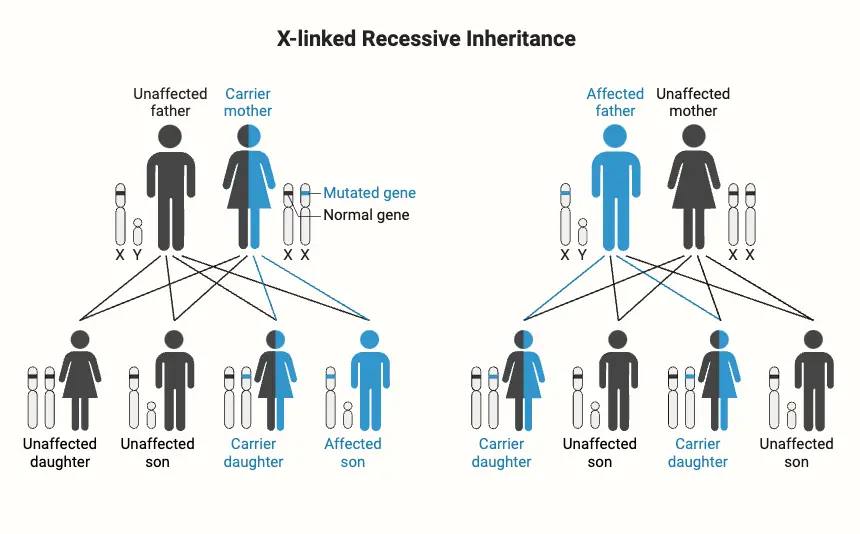
X-Linked Inheritance
- Definition and Overview:
- X-Linked Traits: Genes located on the X chromosome exhibit specific inheritance patterns because females possess two X chromosomes while males have one. Therefore, males are hemizygous for X-linked traits.
- X vs. Y Chromosome: The X chromosome carries a large number of genes essential for both sexes, whereas the Y chromosome contains relatively few genes, mainly those determining maleness.
- X-Linked Dominant Traits:
- Expression: Dominant X-linked genes are expressed in both males and females. A single copy of a dominant X-linked allele is sufficient to manifest the trait.
- Transmission Patterns:
- From Males: A hemizygous male (with one X chromosome) will pass the dominant allele to all of his daughters, but none to his sons, resulting in no father-to-son transmission.
- From Females: Heterozygous females (carrying one dominant allele) transmit the trait to approximately half of their offspring, regardless of sex. Homozygous dominant females pass the trait to all of their children.
- Example: Vitamin D-resistant rickets is an example of an X-linked dominant disorder.
- X-Linked Recessive Traits:
- Expression: Males, being hemizygous for the X chromosome, always express X-linked recessive traits if they possess the recessive allele. Females must be homozygous recessive to express these traits.
- Inheritance Pattern:
- From Males: A recessive X-linked trait transmitted by a male will be inherited by all his daughters, who become carriers but do not express the trait.
- In Female Carriers: Carrier females have a 50% chance of passing the recessive allele to their sons, who will then express the trait if they inherit the recessive allele. The pattern often appears as a criss-cross inheritance, where the trait is observed in alternating generations among males.
- Examples:
- Red-Green Color Blindness: A condition where individuals cannot distinguish between red and green colors. The genes for color perception are located on the X chromosome.
- Hemophilia: A bleeding disorder caused by deficiencies in clotting factors. Hemophilia A, for example, results from a lack of factor VIII, which is necessary for blood clotting.
- Duchenne Muscular Dystrophy (DMD): An X-linked recessive disorder characterized by progressive muscle degeneration, usually beginning in early childhood.
- Glucose-6-Phosphate Dehydrogenase (G-6PD) Deficiency: This condition leads to hemolytic anemia when exposed to certain environmental triggers.
- Congenital Hyperuricemia (Lesch-Nyhan Syndrome): Characterized by excessive uric acid production and severe neurological symptoms.
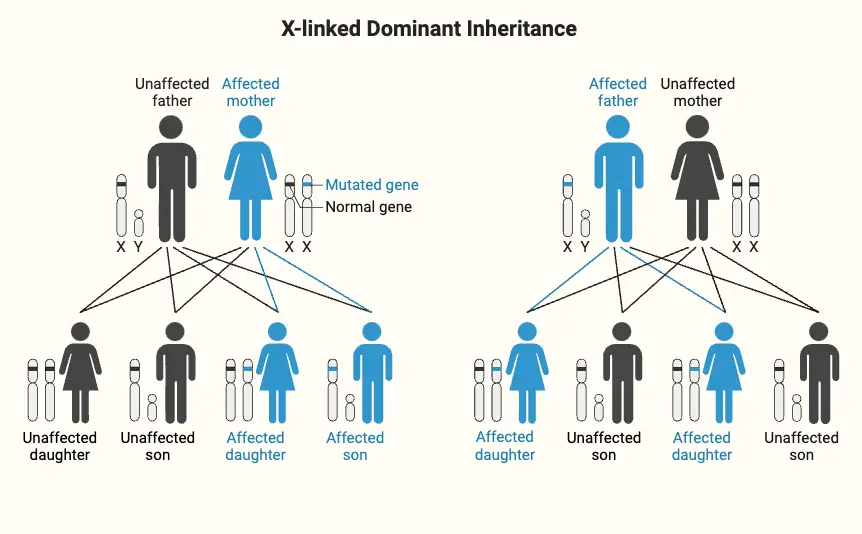
Y-Linked Inheritance
- Definition and Overview:
- Y-Linked Traits: Genes located exclusively on the Y chromosome are referred to as Y-linked or holandric. These genes are inherited strictly from father to son, as females do not possess a Y chromosome.
- Known Y-Linked Traits:
- Histocompatibility Gene (H-Y Gene): This gene is involved in the differentiation of male characteristics and is located on the short arm of the Y chromosome.
- Testis Determining Factor (TDF): This gene is crucial for the development of testes and the subsequent formation of male characteristics.
- Hypertrichosis: A condition leading to excessive hair growth on the pinna (ear) is associated with the Y chromosome and has been observed in various populations worldwide.
Sex-limited And Sex-enfluenced Traits
Sex-limited and sex-influenced traits represent distinct patterns of inheritance that involve autosomal genes and are influenced by the sex of the individual. Unlike sex-linked traits, which are directly associated with genes on the sex chromosomes, these traits arise from autosomal genes whose expression is modulated by the individual’s sex.
Sex-Limited Traits
Sex-limited traits are those that are expressed exclusively in one sex, even though the underlying genes are present in both sexes. The phenotypic expression of these traits depends on the presence or absence of specific sex hormones.
- Definition: Traits controlled by autosomal genes but expressed only in one sex due to the influence of sex hormones.
- Examples in Humans:
- Beard Development: Males develop beards due to the action of androgens, while females generally do not, although the genetic potential for beard growth exists in both sexes.
- Breast Development: Fully developed breasts are a characteristic of females, regulated by estrogen. Males possess the same genetic potential but typically do not develop breasts unless hormonal imbalances occur.
- Prostate Gland Presence: The prostate gland is present in males and absent in females, influenced by male hormones.
- Animal Examples:
- Milk Production in Mammals: Limited to females but influenced by genetic factors present in males. Some male bulls are selected for breeding based on the superior milk production traits of their mothers and daughters.
- Cock Feathering in Birds: In domestic fowl, males exhibit long, ornate feathers (cock-feathering), whereas females have shorter, less elaborate feathers (hen-feathering). This trait is present in both sexes genetically but expressed only in males due to sex hormones.
Sex-Influenced Traits
Sex-influenced traits are those that can appear in both sexes but with different frequencies and expressions. The key characteristic of these traits is that they exhibit different patterns of dominance in males and females.
- Definition: Traits governed by autosomal genes that exhibit different dominance patterns in different sexes.
- Examples in Humans:
- Pattern Baldness: This condition, characterized by hair loss from the top and front of the scalp, is dominant in males (B1 allele) and recessive in females. Males with one or two copies of the B1 allele will exhibit baldness, while females need two copies to show the same phenotype.
- White Forelock: This trait involves a distinctive white patch of hair on the forehead and is expressed differently depending on the sex.
- Absence of Upper Lateral Incisor Teeth: The lack of these teeth may follow a sex-influenced pattern, showing different frequencies or intensities between males and females.
- Cleft Lip: This condition demonstrates variability in expression between the sexes, influenced by hormonal and genetic factors.
- Animal Examples:
- Spotting in Cattle: Spotting patterns, such as mahogany and white in males versus red and white in females, show different dominance patterns.
- Horned vs. Hornless Condition in Sheep: The presence of horns is dominant in males and recessive in females. The gene responsible exhibits sex-influenced inheritance, where its expression varies with the sex of the individual.
Dosage Compensation
Dosage compensation is a crucial biological mechanism that ensures equal expression of X-linked genes between males and females despite differences in the number of X chromosomes. In species with XX-XY sex determination systems, such as humans and fruit flies, males possess one X chromosome, while females have two. This disparity in X chromosome number necessitates a mechanism to balance gene expression levels between the sexes.
Dosage Compensation in Humans
In humans and other mammals, dosage compensation is achieved through the inactivation of one of the X chromosomes in females. This process ensures that both sexes have a similar dosage of X-linked gene products.
- Mechanism:
- X-Chromosome Inactivation: In females, one of the two X chromosomes in each cell is randomly inactivated early in development. This inactive X chromosome condenses into a form known as heterochromatin and is visible as a Barr body.
- Barr Body Formation: The Barr body is the condensed, inactive X chromosome observed in female cells. Females with more than two X chromosomes will have all but one X chromosome inactivated.
- Lyon Hypothesis:
- Origin: Proposed by Mary F. Lyon in 1961, this hypothesis states that inactivation occurs randomly in early development, leading to a mosaic pattern of X-linked gene expression in females.
- Evidence: This hypothesis is supported by observations of individuals with atypical numbers of X chromosomes. For example:
- Turner’s Syndrome (45, XO): Females with one X chromosome have no Barr bodies.
- Klinefelter’s Syndrome (47, XXY): Males with an extra X chromosome have one Barr body.
- Triple X Syndrome (47, XXX): Females with an extra X chromosome have two Barr bodies.
- Other Aneuploidies: Various conditions with additional X chromosomes show a corresponding number of Barr bodies.
- Functional Implications:
- Mosaicism: Heterozygous females for X-linked traits exhibit mosaicism, where different cells express different X-linked alleles. This can lead to variable expression of X-linked traits, such as in calico cats, where coat color patterns result from the random inactivation of one X chromosome.
- Examples in Humans:
- Color Blindness: Females heterozygous for X-linked color blindness may have cells with normal vision and cells with color blindness, leading to overall normal color vision.
- G-6PD Deficiency: In heterozygous females, cells may express either of two enzyme types (G-6PD type A or B), demonstrating clonal inheritance of X-chromosome inactivation.
- Reactivation:
- Germ Cells: During oogenesis, both X chromosomes in females become active again to ensure that each egg contains a fully functional X chromosome. This reactivation is necessary for proper development and transmission of X-linked genes to offspring.
Dosage Compensation in Drosophila
In contrast to mammals, fruit flies (Drosophila melanogaster) achieve dosage compensation through a different mechanism.
- Mechanism:
- Increased Transcription: In fruit flies, males have one X chromosome, while females have two. Dosage compensation is accomplished by doubling the transcriptional activity of the single X chromosome in males to match the activity level of the two X chromosomes in females.
- Cytological Evidence: This increased transcription is visible as “puffed” bands in the X chromosomes of male salivary gland cells, indicating higher levels of gene expression compared to female cells.
- Absence of Barr Bodies: Unlike mammals, fruit flies do not form Barr bodies, as the mechanism of dosage compensation relies on increased transcription rather than chromosomal inactivation.
Significance of Sex Determination
Sex determination is a critical process in various biological, medical, and social contexts. It involves identifying the sex of an individual, which can have significant implications in several areas:
- Medical Diagnosis and Treatment: Understanding an individual’s sex can be crucial for diagnosing and treating certain diseases. Some genetic disorders, like hemophilia or Duchenne muscular dystrophy, are sex-linked and primarily affect one sex. Personalized medicine often requires knowledge of sex to tailor treatments effectively.
- Genetics and Development: Sex determination plays a key role in the development of sexual characteristics and reproductive organs. In humans, sex is typically determined by the presence of XX (female) or XY (male) chromosomes, but variations in this process can lead to intersex conditions. Understanding these mechanisms helps in studying developmental biology and genetics.
- Forensic Science: In forensic investigations, sex determination from DNA evidence can be crucial in identifying individuals and solving cases. Accurate determination helps narrow down suspects and establish the identity of unknown individuals.
- Population Studies and Ecology: In ecology, sex determination can impact population dynamics and conservation efforts. Knowledge about the sex ratio in populations of endangered species can inform conservation strategies and help manage breeding programs.
- Agriculture and Livestock Management: In agriculture, sex determination is important for managing livestock and poultry. For example, in poultry farming, determining the sex of chicks can help optimize production and reduce costs, as only one sex may be needed for specific purposes.
- Social and Psychological Aspects: Understanding sex determination has implications for gender identity and roles. It contributes to discussions about sex and gender diversity, and how these concepts impact individuals’ experiences and societal expectations.
Facts
- Did you know that in humans, the XX chromosome combination usually results in a female and XY results in a male, but other organisms can use different mechanisms like temperature to determine sex?
- Have you heard that in female mammals, including humans, one of the two X chromosomes is randomly “turned off,” creating a mosaic pattern of gene expression that can result in unique traits like the calico coloration in cats?
- Are you aware that the Y chromosome, which is much smaller than the X chromosome, contains the crucial SRY gene that initiates the development of male characteristics?
- Did you know that in some reptiles, like certain turtles and crocodiles, the sex of the offspring is determined by the incubation temperature of the eggs rather than genetic factors?
- Can you believe that some species, such as certain lizards and insects, can reproduce without mating through parthenogenesis, producing offspring that are genetically identical to the mother and typically of the same sex?
- Have you ever heard that certain animals, like clownfish, can change their sex during their lifetime, with clownfish starting as males and becoming females if the dominant female dies?
- Did you know that in fruit flies, dosage compensation is achieved by doubling the transcriptional activity of genes on the single X chromosome in males to balance the gene dosage between males and females?
- Are you aware that conditions like Turner syndrome (45, XO) and Klinefelter syndrome (47, XXY) illustrate how variations in sex chromosome number can affect physical and developmental traits in humans?
- Did you know that the Y chromosome has dramatically shrunk over evolutionary time, losing many of its original genes and becoming much smaller compared to the X chromosome?
- Have you ever considered that some plants have sex chromosomes similar to animals, while others can exhibit multiple sexes or no distinct sex chromosomes at all, such as the holly plant with its male, female, or hermaphroditic individuals?
- https://egyankosh.ac.in/bitstream/123456789/71275/1/Unit-7.pdf
- https://www.geeksforgeeks.org/sex-determination/
- https://www.lkouniv.ac.in/site/writereaddata/siteContent/202004101403394160vibha_bajpai_anthro_genetics.pdf
- https://www.mlsu.ac.in/econtents/801_SEX%20DETERMINATION%20THEORIES.pdf
- https://www.pw.live/chapter-heredity-and-evolution/sex-determination
- https://www.onlinebiologynotes.com/sex-determination-in-human-and-role-of-various-genes/
- https://ocd.lcwu.edu.pk/cfiles/Biotechnology/Maj/Biotech-103/GENETICSLECT17.pdf
- Text Highlighting: Select any text in the post content to highlight it
- Text Annotation: Select text and add comments with annotations
- Comment Management: Edit or delete your own comments
- Highlight Management: Remove your own highlights
How to use: Simply select any text in the post content above, and you'll see annotation options. Login here or create an account to get started.